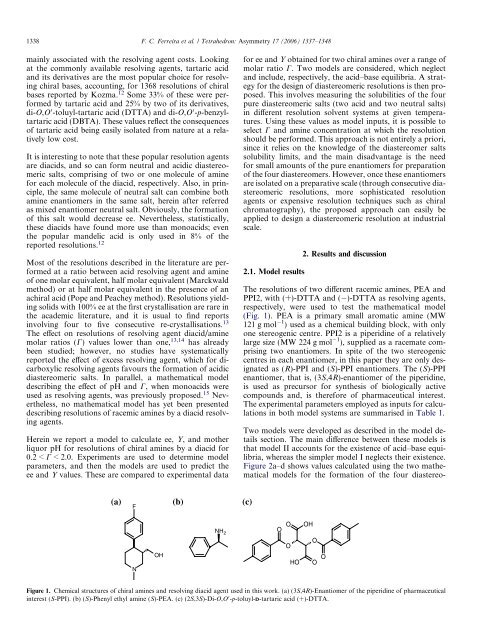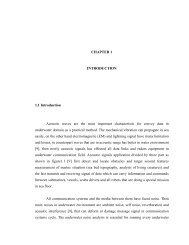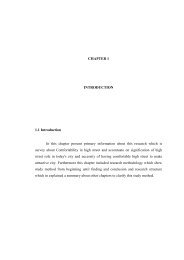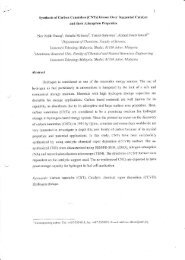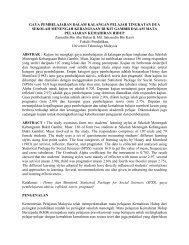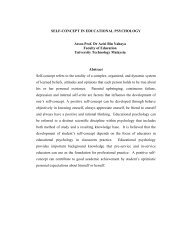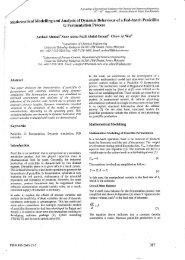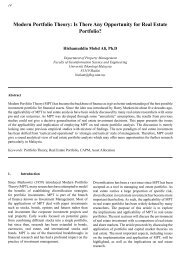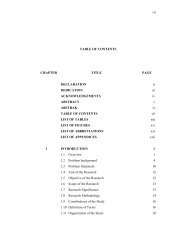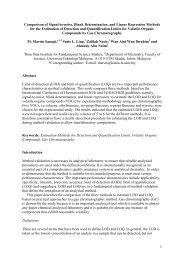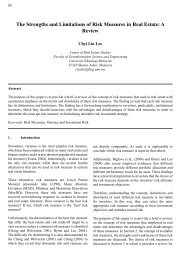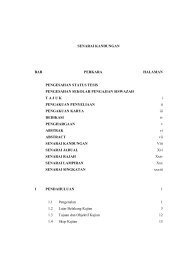Rational approach to the selection of conditions for diastereomeric ...
Rational approach to the selection of conditions for diastereomeric ...
Rational approach to the selection of conditions for diastereomeric ...
Create successful ePaper yourself
Turn your PDF publications into a flip-book with our unique Google optimized e-Paper software.
1338 F. C. Ferreira et al. / Tetrahedron: Asymmetry 17 (2006) 1337–1348<br />
mainly associated with <strong>the</strong> resolving agent costs. Looking<br />
at <strong>the</strong> commonly available resolving agents, tartaric acid<br />
and its derivatives are <strong>the</strong> most popular choice <strong>for</strong> resolving<br />
chiral bases, accounting, <strong>for</strong> 1368 resolutions <strong>of</strong> chiral<br />
bases reported by Kozma. 12 Some 33% <strong>of</strong> <strong>the</strong>se were per<strong>for</strong>med<br />
by tartaric acid and 25% by two <strong>of</strong> its derivatives,<br />
di-O,O 0 -<strong>to</strong>luyl-tartaric acid (DTTA) and di-O,O 0 -p-benzyltartaric<br />
acid (DBTA). These values reflect <strong>the</strong> consequences<br />
<strong>of</strong> tartaric acid being easily isolated from nature at a relatively<br />
low cost.<br />
It is interesting <strong>to</strong> note that <strong>the</strong>se popular resolution agents<br />
are diacids, and so can <strong>for</strong>m neutral and acidic <strong>diastereomeric</strong><br />
salts, comprising <strong>of</strong> two or one molecule <strong>of</strong> amine<br />
<strong>for</strong> each molecule <strong>of</strong> <strong>the</strong> diacid, respectively. Also, in principle,<br />
<strong>the</strong> same molecule <strong>of</strong> neutral salt can combine both<br />
amine enantiomers in <strong>the</strong> same salt, herein after referred<br />
as mixed enantiomer neutral salt. Obviously, <strong>the</strong> <strong>for</strong>mation<br />
<strong>of</strong> this salt would decrease ee. Never<strong>the</strong>less, statistically,<br />
<strong>the</strong>se diacids have found more use than monoacids; even<br />
<strong>the</strong> popular mandelic acid is only used in 8% <strong>of</strong> <strong>the</strong><br />
reported resolutions. 12<br />
Most <strong>of</strong> <strong>the</strong> resolutions described in <strong>the</strong> literature are per<strong>for</strong>med<br />
at a ratio between acid resolving agent and amine<br />
<strong>of</strong> one molar equivalent, half molar equivalent (Marckwald<br />
method) or at half molar equivalent in <strong>the</strong> presence <strong>of</strong> an<br />
achiral acid (Pope and Peachey method). Resolutions yielding<br />
solids with 100% ee at <strong>the</strong> first crystallisation are rare in<br />
<strong>the</strong> academic literature, and it is usual <strong>to</strong> find reports<br />
involving four <strong>to</strong> five consecutive re-crystallisations. 13<br />
The effect on resolutions <strong>of</strong> resolving agent diacid/amine<br />
molar ratios (C) values lower than one, 13,14 has already<br />
been studied; however, no studies have systematically<br />
reported <strong>the</strong> effect <strong>of</strong> excess resolving agent, which <strong>for</strong> dicarboxylic<br />
resolving agents favours <strong>the</strong> <strong>for</strong>mation <strong>of</strong> acidic<br />
<strong>diastereomeric</strong> salts. In parallel, a ma<strong>the</strong>matical model<br />
describing <strong>the</strong> effect <strong>of</strong> pH and C, when monoacids were<br />
used as resolving agents, was previously proposed. 15 Never<strong>the</strong>less,<br />
no ma<strong>the</strong>matical model has yet been presented<br />
describing resolutions <strong>of</strong> racemic amines by a diacid resolving<br />
agents.<br />
Herein we report a model <strong>to</strong> calculate ee, Y, and mo<strong>the</strong>r<br />
liquor pH <strong>for</strong> resolutions <strong>of</strong> chiral amines by a diacid <strong>for</strong><br />
0.2 < C < 2.0. Experiments are used <strong>to</strong> determine model<br />
parameters, and <strong>the</strong>n <strong>the</strong> models are used <strong>to</strong> predict <strong>the</strong><br />
ee and Y values. These are compared <strong>to</strong> experimental data<br />
<strong>for</strong> ee and Y obtained <strong>for</strong> two chiral amines over a range <strong>of</strong><br />
molar ratio C. Two models are considered, which neglect<br />
and include, respectively, <strong>the</strong> acid–base equilibria. A strategy<br />
<strong>for</strong> <strong>the</strong> design <strong>of</strong> <strong>diastereomeric</strong> resolutions is <strong>the</strong>n proposed.<br />
This involves measuring <strong>the</strong> solubilities <strong>of</strong> <strong>the</strong> four<br />
pure <strong>diastereomeric</strong> salts (two acid and two neutral salts)<br />
in different resolution solvent systems at given temperatures.<br />
Using <strong>the</strong>se values as model inputs, it is possible <strong>to</strong><br />
select C and amine concentration at which <strong>the</strong> resolution<br />
should be per<strong>for</strong>med. This <strong>approach</strong> is not entirely a priori,<br />
since it relies on <strong>the</strong> knowledge <strong>of</strong> <strong>the</strong> diastereomer salts<br />
solubility limits, and <strong>the</strong> main disadvantage is <strong>the</strong> need<br />
<strong>for</strong> small amounts <strong>of</strong> <strong>the</strong> pure enantiomers <strong>for</strong> preparation<br />
<strong>of</strong> <strong>the</strong> four diastereomers. However, once <strong>the</strong>se enantiomers<br />
are isolated on a preparative scale (through consecutive <strong>diastereomeric</strong><br />
resolutions, more sophisticated resolution<br />
agents or expensive resolution techniques such as chiral<br />
chroma<strong>to</strong>graphy), <strong>the</strong> proposed <strong>approach</strong> can easily be<br />
applied <strong>to</strong> design a <strong>diastereomeric</strong> resolution at industrial<br />
scale.<br />
2.1. Model results<br />
2. Results and discussion<br />
The resolutions <strong>of</strong> two different racemic amines, PEA and<br />
PPI2, with (+)-DTTA and ( )-DTTA as resolving agents,<br />
respectively, were used <strong>to</strong> test <strong>the</strong> ma<strong>the</strong>matical model<br />
(Fig. 1). PEA is a primary small aromatic amine (MW<br />
121 g mol<br />
1 ) used as a chemical building block, with only<br />
one stereogenic centre. PPI2 is a piperidine <strong>of</strong> a relatively<br />
large size (MW 224 g mol<br />
1 ), supplied as a racemate comprising<br />
two enantiomers. In spite <strong>of</strong> <strong>the</strong> two stereogenic<br />
centres in each enantiomer, in this paper <strong>the</strong>y are only designated<br />
as (R)-PPI and (S)-PPI enantiomers. The (S)-PPI<br />
enantiomer, that is, (3S,4R)-enantiomer <strong>of</strong> <strong>the</strong> piperidine,<br />
is used as precursor <strong>for</strong> syn<strong>the</strong>sis <strong>of</strong> biologically active<br />
compounds and, is <strong>the</strong>re<strong>for</strong>e <strong>of</strong> pharmaceutical interest.<br />
The experimental parameters employed as inputs <strong>for</strong> calculations<br />
in both model systems are summarised in Table 1.<br />
Two models were developed as described in <strong>the</strong> model details<br />
section. The main difference between <strong>the</strong>se models is<br />
that model II accounts <strong>for</strong> <strong>the</strong> existence <strong>of</strong> acid–base equilibria,<br />
whereas <strong>the</strong> simpler model I neglects <strong>the</strong>ir existence.<br />
Figure 2a–d shows values calculated using <strong>the</strong> two ma<strong>the</strong>matical<br />
models <strong>for</strong> <strong>the</strong> <strong>for</strong>mation <strong>of</strong> <strong>the</strong> four diastereo-<br />
(a) (b) (c)<br />
F<br />
N<br />
OH<br />
NH 2<br />
O<br />
O<br />
O<br />
HO<br />
OH<br />
O<br />
O<br />
O<br />
Figure 1. Chemical structures <strong>of</strong> chiral amines and resolving diacid agent used in this work. (a) (3S,4R)-Enantiomer <strong>of</strong> <strong>the</strong> piperidine <strong>of</strong> pharmaceutical<br />
interest (S-PPI). (b) (S)-Phenyl ethyl amine (S)-PEA. (c) (2S,3S)-Di-O,O 0 -p-<strong>to</strong>luyl-D-tartaric acid (+)-DTTA.


